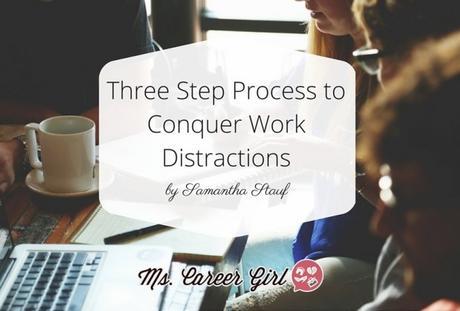
Do you ever leave work for the day and then wonder: what did I do today? That, my friend, is a huge sign that distraction might be reigning terror on your work life. Distractions tyrannical reign begins slowly. A minute here. A minute there. By the end of the day, hours of the work day are wasted. Hours you could not afford to lose. The lost time can lead the inability to perform your duties. The inability to meet basic job expectations can lead to stress that feeds into poor job performance, employee burn out, and poor physical and mental health. Employees can decrease distractions that lead to stress with an easy three step process designed to decrease distractions.
The three step process presented below is derived from the extensive research conducted by Rutgers professor Dr. John R. Aiello. Dr. Aiellio has spent a large portion of his educational career studying work stress and performance monitoring. In " Control and Anticipation of Social Interruptions: Reduced Stress and Improved Task Performance," Aiellio reveals that anticipation is imperative to decreasing the period you will need to recover from the interruption. Therefore, the three step process will focus on pro-actively dealing with distractions.
Step 1: Identification
Spend about ten minutes jotting down as many distractions that you encountered at work in the last week. Once you have the master list of distractions, monitor what distractions continue to remain a problem at the end of every day.
Example: Barbara seems to spend her days being pulled from her work for spontaneous meetings. Sometimes by the time she's ready to dive into work again, management pulls her into another meeting.
Step 2: Analysis
Analyze how often the distractions happen. Here are a few questions to ask yourself about every distraction. The main point of the second step is to set a framework on how you can potentially deal with the issue.
- How often does the distraction occur? Once a week? Every day? A few times a day?
- Who instigates the distraction? A co-worker? You? A manager?
- How much time do you lose every time you face the distraction?
Example: The spontaneous meetings happen at least two or three times a day and last for about an hour. It sometimes takes Barbara 15 minutes to get back into her work after the meeting. The meetings are arranged mostly by managers (but sometimes her co-workers pull her into them).
Step 3: Implementation of Defense
Once you have completed the analysis, take a few moments to craft a battle plan for the distractions you will face. Focus should be placed on strategizing how to anticipate interruptions to your workflow. Remember, Dr. Aiellio found that individuals who knew when the interruption would take place were able to jump back into work quicker and perform better, so you should focus on trying to schedule unavoidable distractions.
Example: Talk to managers about pre-planning when the meeting will be held each day. Ask co-workers to let you know in the morning if they would like to strategize that day.
Distractions can be mitigated through thoughtful analysis of the problem and implementation of a plan. If you still find yourself having problems focusing at work, don't continually try to face-down the problem alone. Try to brainstorm ways to deal with the issue with your manager or your co-workers. The success of the team hinges on every individuals ability to perform, so they will help you strategize ways to increase your focus. It's up to you to ensure you receive the help necessary to survive and thrive in the office.

